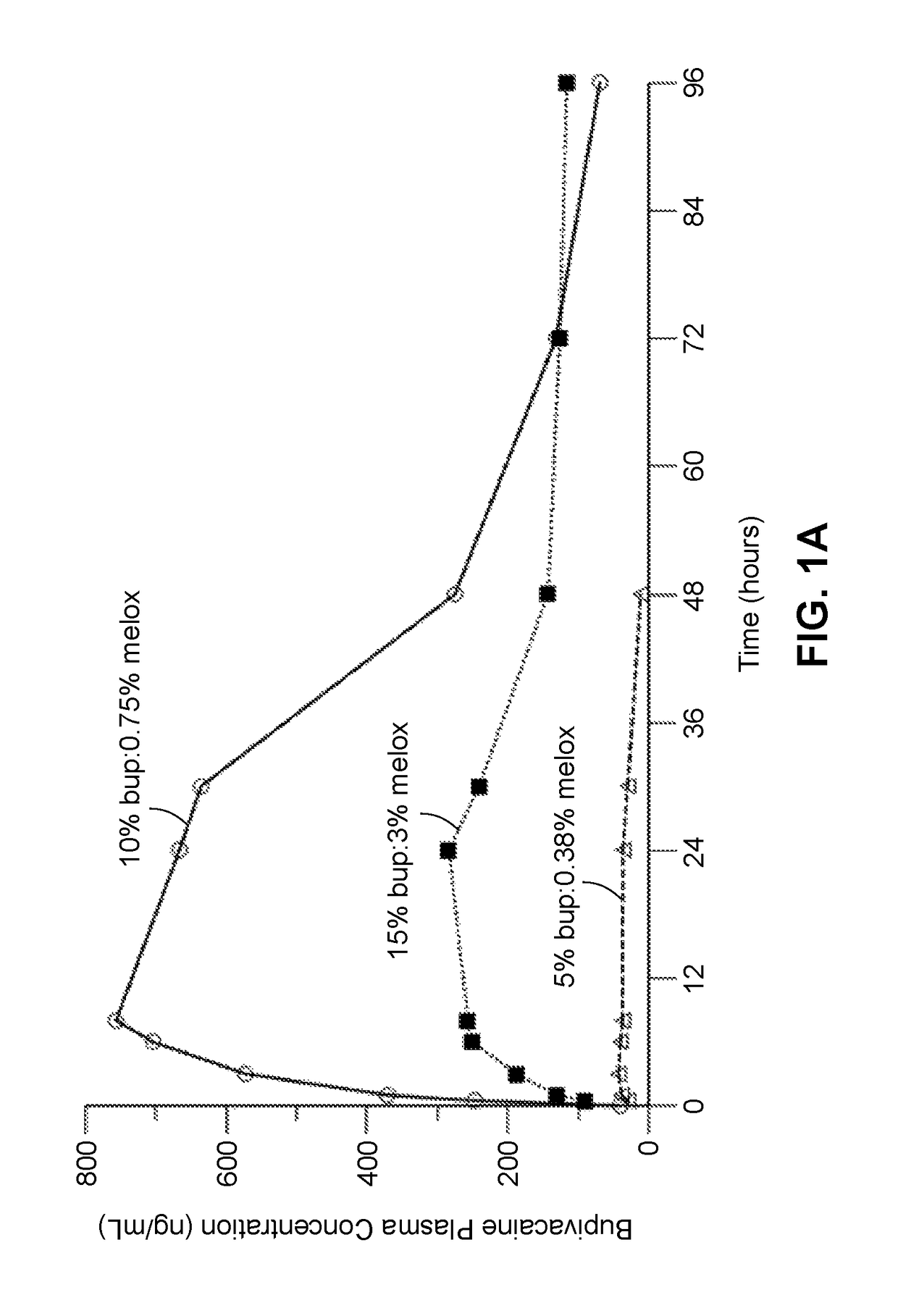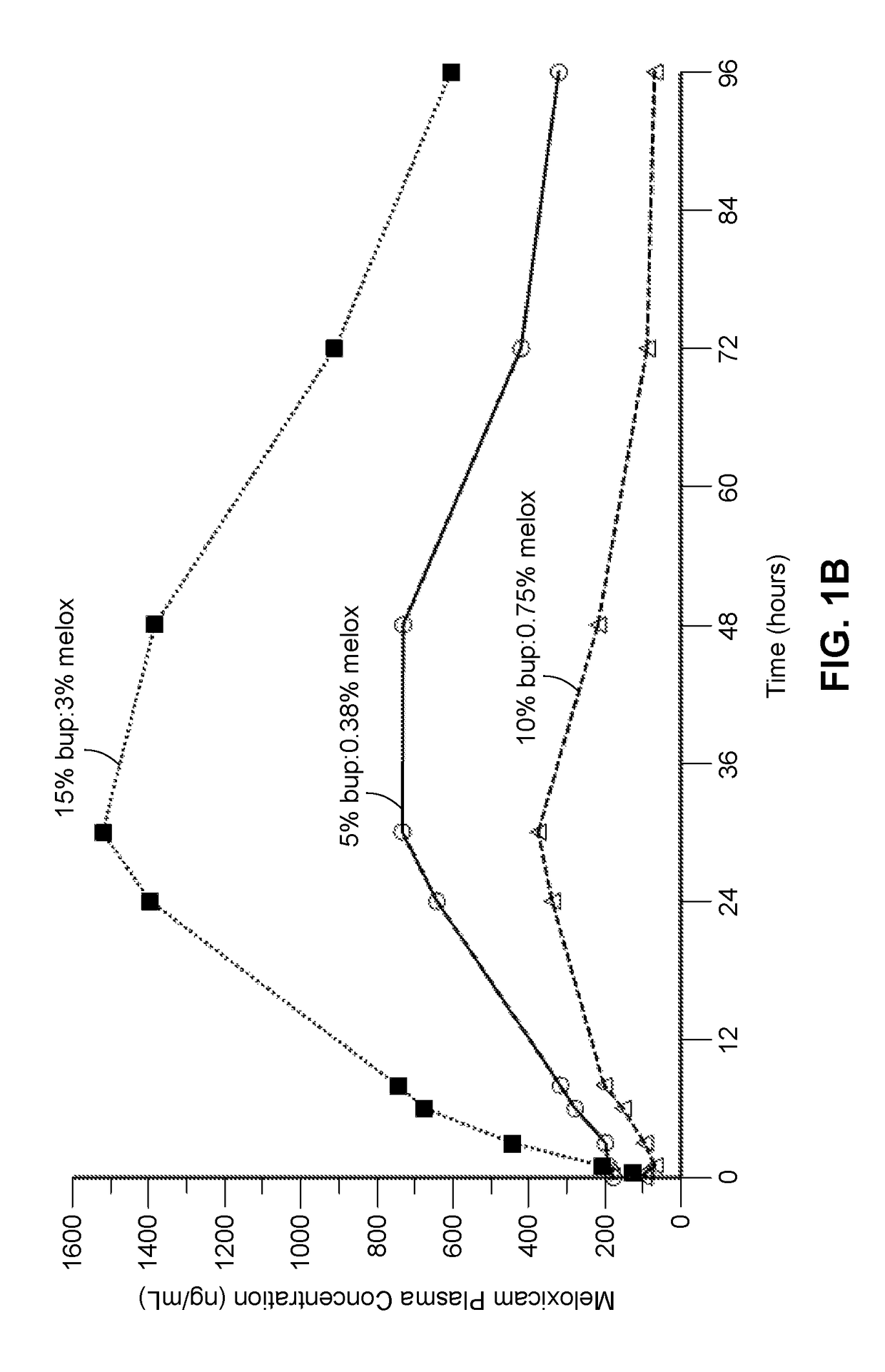Long-acting polymeric delivery systems
a polymer and long-acting technology, applied in the direction of organic active ingredients, surgery, heterocyclic compound active ingredients, etc., can solve the problems of opioids carrying many undesirable side effects, increasing morbidity or mortality, and failing to follow clinical practice implications
- Summary
- Abstract
- Description
- Claims
- Application Information
AI Technical Summary
Benefits of technology
Problems solved by technology
Method used
Image
Examples
example 1
Composition Comprising Ropivacaine and a Non-Steroidal Anti-Inflammatory Drug
[0366]A composition containing the polyorthoester of Formula I, an aprotic solvent, ropivacaine, and meloxicam was prepared with the amount of each component set forth in Table 1-1 below. The composition was prepared by dissolving the NSAID into the aprotic solvent at approximately 80° C. and then adding the ropivacaine with heating until dissolved, to form a drug solution. The drug solution was mixed with the polyorthoester at an elevated temperature, until homogeneous.
[0367]
TABLE 1-1Compo-sitionSolventRopivacaineMeloxicam%%IDIDBase %%PolyorthoestersSolvent8026-NMP5.2%3.6%61.5%29.7%01-01*NMP = N-methylpyrrolidone;POE = polyorthoester
example 2
In Vitro Release of Ropivacaine and Meloxicam from a Polyorthoester Composition
[0368]The release of ropivacaine and meloxicam from the composition in Example 1 was determined by placing 50 mg of the polymer composition from Example 1 into a vial filled with 150 mL of phosphate buffered saline (PBS). The vial was then incubated at 37° C. without agitation. At 24 hour intervals, 1 mL samples of the PBS were taken from the vial without agitation of the solution. Each sample was analyzed by HPLC to determine the concentration of ropivacaine and meloxicam. The cumulative drug release as a function of time from the 50 mg depot was determined. Results are shown in Table 2-1 below.
[0369]
TABLE 2-1In Vitro Release of Ropivacaine and MeloxicamCumulativePercent Drug Releasedfor CompositionComposition #Drug24 hrs48 hrs72 hrs8026-01-01Ropivacaine52.888.5100.08026-01-01Meloxicam39.085.3100.0
example 3
Delivery Systems Comprising Bupivacaine and Diclofenac
[0370]Compositions containing between approximately 62-63% polyorthoester of Formula I, between approximately 15-20% of an aprotic solvent, between 10% and 15% bupivacaine base, and 6% to 7.5% diclofenac were prepared. The compositions were prepared by first dissolving an appropriate amount of diclofenac into an appropriate amount of aprotic solvent at approximately 80° C. and then dissolving bupivacaine into the solution. The drug solution was then mixed with an appropriate amount of polymer at an elevated temperature, until homogeneous. Exemplary compositions are presented in Table 3-1.
[0371]
TABLE 3-1CompositionSolventWt %Wt %Wt %Wt %IDIDBupivacaineDiclofenacPOESolvent8026-03-01NMP10.2%6.06%63.52%20.22%8026-03-02NMP15.0% 7.5% 62.0% 15.5%*NMP = N-methylpyrrolidone;POE = polyorthoester
PUM
 Login to View More
Login to View More Abstract
Description
Claims
Application Information
 Login to View More
Login to View More - R&D
- Intellectual Property
- Life Sciences
- Materials
- Tech Scout
- Unparalleled Data Quality
- Higher Quality Content
- 60% Fewer Hallucinations
Browse by: Latest US Patents, China's latest patents, Technical Efficacy Thesaurus, Application Domain, Technology Topic, Popular Technical Reports.
© 2025 PatSnap. All rights reserved.Legal|Privacy policy|Modern Slavery Act Transparency Statement|Sitemap|About US| Contact US: help@patsnap.com



